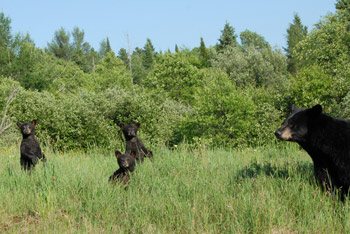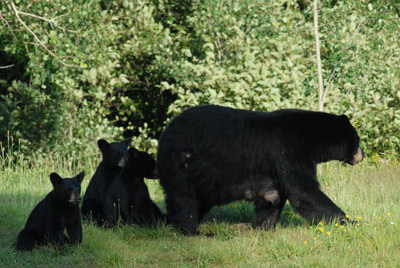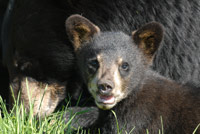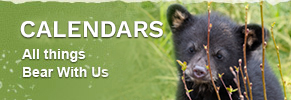 Cubs are born in January after a gestation period of approximately 7 months. Although mating occurs in June, fetal development takes place mainly in the last 2 months of pregnancy after the fertilized egg implants in the uterus in November (delayed implantation). Fetuses develop only if the mother has stored enough body fat and other nutrients to survive overwinter and provide milk for her cubs until she resumes feeding in spring (nature’s way of bear birth control). At birth, the cubs weigh less than a pound, have only a light covering of fur, and can barely crawl. The mother eats the birth membranes, licks the cubs, and warms them against her thinly furred belly. She moves in response to the cubs’ cries and comfort sounds, making it easy for them to nurse and shifting her weight so as not to rest too heavily on them. With the full time babysitting job keeping the mother bear awake, nursing mothers often lose a third or more if their body weight over winter, while non-nursing bears lose only 15 to 25 percent.
Cubs are born in January after a gestation period of approximately 7 months. Although mating occurs in June, fetal development takes place mainly in the last 2 months of pregnancy after the fertilized egg implants in the uterus in November (delayed implantation). Fetuses develop only if the mother has stored enough body fat and other nutrients to survive overwinter and provide milk for her cubs until she resumes feeding in spring (nature’s way of bear birth control). At birth, the cubs weigh less than a pound, have only a light covering of fur, and can barely crawl. The mother eats the birth membranes, licks the cubs, and warms them against her thinly furred belly. She moves in response to the cubs’ cries and comfort sounds, making it easy for them to nurse and shifting her weight so as not to rest too heavily on them. With the full time babysitting job keeping the mother bear awake, nursing mothers often lose a third or more if their body weight over winter, while non-nursing bears lose only 15 to 25 percent.
By the time the cubs toddle out of the den at 2 to 3 months of age, they weigh 4 to 6 pounds, depending on how much milk their mother produced and how many littermates they shared it with. The better developed cubs cab immediately climb trees but cannot outrun wolves or other bears. Their mother defends them, warms them, and nurses them, sometimes sitting and cradling them in her forelegs while licking their heads and nursing them. Foraging mothers come immediately when their cubs cry. If need be, a mother will carry a cub in her mouth to a new location or will gently grasp a crying cub in her mouth to help is down from a tree. Spanking cubs toward trees in time of danger is uncommon.
 Cubs taste what their mothers eat in the month after emerging from dens, but they do not begin eating solid food until their chewing teeth erupt later in spring. They continue to suckle nearly until they hibernate in fall. Father bears do not help in raising the cubs and would probably be more competition than help if they tried.
Cubs taste what their mothers eat in the month after emerging from dens, but they do not begin eating solid food until their chewing teeth erupt later in spring. They continue to suckle nearly until they hibernate in fall. Father bears do not help in raising the cubs and would probably be more competition than help if they tried.
In fall, mothers do most of the den construction, but the cubs help rake leaves and twigs for bedding. They sleep snuggled together for warmth and protection with the mother nearest to the entrance.
The next spring, mothers continue to lead and protect their cubs until June, when the cubs are about 17 months old and the mother becomes ready to mate again. Then she suddenly becomes intolerant of her yearlings and threatens (chases) them away. She recognizes them for several years, possibly indefinitely, allowing them to remain in parts of her territory which she then avoids. She ejects trespassing bears that could compete with her offspring and herself.  Female offspring use even larger portions of their mother’s territory until they reach maturity. Meanwhile, the mother shifts her territory to include new adjacent areas if such areas are available, or tolerates overlap with her daughters if other areas are not available. Young males voluntarily leave their mothers’ territories before reaching maturity, traveling up to 137 miles or more before settling down and establishing mating ranges.
Female offspring use even larger portions of their mother’s territory until they reach maturity. Meanwhile, the mother shifts her territory to include new adjacent areas if such areas are available, or tolerates overlap with her daughters if other areas are not available. Young males voluntarily leave their mothers’ territories before reaching maturity, traveling up to 137 miles or more before settling down and establishing mating ranges.
Credits: University of Minnesota, Dr. Lynn Rogers. Photos and Video – Mike McIntosh


